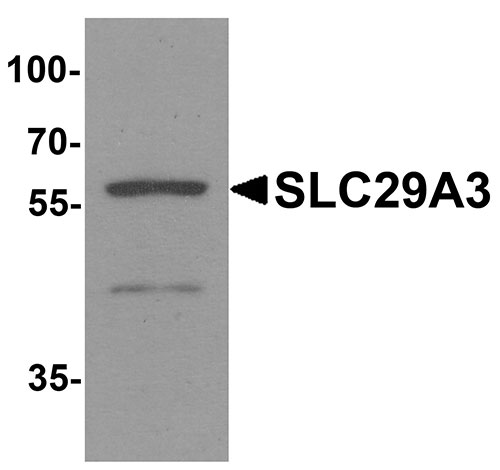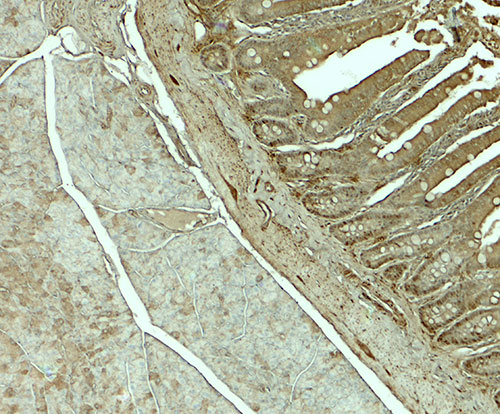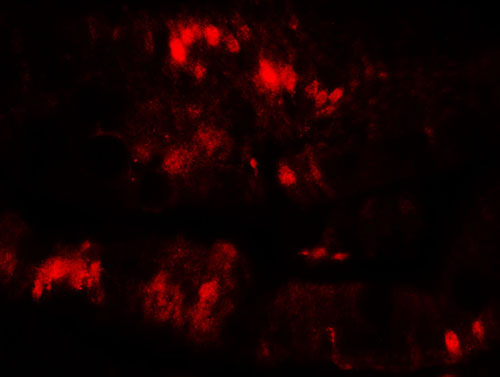SLC29A3 Antibody
- 产品详情
- 实验流程
- 背景知识
Application
| WB, IF, E, IHC-P |
|---|---|
| Primary Accession | Q9BZD2 |
| Other Accession | NP_060814, 148596922 |
| Reactivity | Human, Mouse, Rat |
| Host | Rabbit |
| Clonality | Polyclonal |
| Isotype | IgG |
| Calculated MW | 51815 Da |
| Concentration (mg/ml) | 1 mg/mL |
| Conjugate | Unconjugated |
| Application Notes | SLC29A3 antibody can be used for detection of SLC29A3 by Western blot at 1 - 2 µg/mL. Antibody can also be used for immunohistochemistry starting at 5 µg/mL. For immunofluorescence start at 20 µg/mL. |
| Gene ID | 55315 |
|---|---|
| Other Names | Equilibrative nucleoside transporter 3, hENT3, Solute carrier family 29 member 3, SLC29A3, ENT3 |
| Target/Specificity | SLC29A3; SLC29A3 antibody is human, mouse and rat reactive. At least two isoforms of SLC29A3 are known to exist; this antibody will detect both isoforms. SLC29A3 antibody is predicted to not cross-react with other SLC29 proteins. |
| Reconstitution & Storage | SLC29A3 antibody can be stored at 4℃ for three months and -20℃, stable for up to one year. |
| Precautions | SLC29A3 Antibody is for research use only and not for use in diagnostic or therapeutic procedures. |
| Name | SLC29A3 (HGNC:23096) |
|---|---|
| Synonyms | ENT3 |
| Function | Uniporter that mediates the facilitative transport of nucleoside across lysosomal and mitochondrial membranes (PubMed:15701636, PubMed:19164483, PubMed:20595384, PubMed:28729424). Functions as a non-electrogenic Na(+)-independent transporter (PubMed:15701636, PubMed:19164483, PubMed:28729424). Substrate transport is pH-dependent and enhanced under acidic condition, probably reflecting the location of the transporter in acidic intracellular compartments (PubMed:15701636, PubMed:19164483, PubMed:28729424). Proton is not a cotransporting ion but most likely change the ionization state of the transporter which dictates transport- permissible/impermissible conformation for nucleoside translocation (PubMed:28729424). May direct the nucleoside transport from lysosomes to cytosol or cytosol to mitochondria to facilitate the fundamental function of salvage synthesis of nucleic acids (PubMed:28729424). Involved in the transport of nucleosides (adenosine, guanosine, uridine, thymidine, cytidine and inosine) and deoxynucleosides (deoxyadenosine, deoxycytidine) (PubMed:15701636, PubMed:19164483, PubMed:20595384, PubMed:28729424). Also mediates transport of purine nucleobases (adenine, guanine) and pyrimidine nucleobases (uracil) (PubMed:15701636, PubMed:19164483). Also able to transport monoamine neurotransmitters dopamine, serotonin, noradrenaline and tyramine (PubMed:19164483). Capable of transporting ATP (PubMed:19164483). Mediates nucleoside export from lysosomes in macrophages, which regulates macrophage functions and numbers (By similarity). |
| Cellular Location | Lysosome membrane; Multi-pass membrane protein. Late endosome membrane; Multi-pass membrane protein. Mitochondrion membrane; Multi-pass membrane protein. Cell membrane; Multi-pass membrane protein. Note=Observed in a punctate intracellular pattern showing partial colocalization with late endosomes/lysosomes (PubMed:15701636). Detected at the cell surface only in certain placental cells (PubMed:19164483) |
| Tissue Location | Widely expressed in both adult and fetal tissues (PubMed:15701636). Highest levels in placenta, uterus, ovary, spleen, lymph node and bone marrow (PubMed:15701636). Expressed in liver (PubMed:19164483). Lowest levels in brain and heart (PubMed:15701636) Expressed in macrophages (PubMed:22174130) |
For Research Use Only. Not For Use In Diagnostic Procedures.
Provided below are standard protocols that you may find useful for product applications.
BACKGROUND
SLC29A3 is a member of the equilibrative nucleoside transporter family which plays a key role in nucleoside and nucleobase uptake for salvage pathways of nucleotide synthesis (1,2). SLC29A3 is a transmembrane glycoprotein that localizes to the lysosomal membrane and is a broad selectivity, low affinity nucleoside transporter (3). Mutations in the SLC29A3 gene have been associated with H syndrome, which is characterized by cutaneous hyperpigmentation and hypertrichosis, hepatosplenomegaly, heart anomalies, and hypogonadism (4). A related disorder, PHID (pigmented hypertrichosis with insulin-dependent diabetes mellitus), has also been associated with mutations at this locus (5).
REFERENCES
Hyde RJ, Cass CE, Young JD, et al. The ENT family of eukaryotic nucleoside and nucleobase transporters: recent advances in the investigation of structure/function relationships and the identification of novel isoforms. Mol. Membr. Biol. 2001; 18:53-63.
Young JD, Yao SY, Baldwin JM, et al. The human concentrative and equilibrative nucleoside transporter families, SLC28 and SLC29. Mol. Aspects. Med. 34:529-47.
Baldwin SA, Yao SY, Hyde RJ, et al. Functional characterization of novel human and mouse equilibrative nucleoside transporters (hENT3 and mENT3) located in intracellular membranes. J. Biol. Chem. 2005; 280:15880-7.
Priya TP, Philip N, Molho-Pessach V, et al. H syndrome: novel and recurrent mutations in SLC29A3. Br. J. Dermatol. 2010; 162:1132-4.
终于等到您。ABCEPTA(百远生物)抗体产品。
点击下方“我要评价 ”按钮提交您的反馈信息,您的反馈和评价是我们最宝贵的财富之一,
我们将在1-3个工作日内处理您的反馈信息。
如有疑问,联系:0512-88856768 tech-china@abcepta.com.























 癌症的基本特征包括细胞增殖、血管生成、迁移、凋亡逃避机制和细胞永生等。找到癌症发生过程中这些通路的关键标记物和对应的抗体用于检测至关重要。
癌症的基本特征包括细胞增殖、血管生成、迁移、凋亡逃避机制和细胞永生等。找到癌症发生过程中这些通路的关键标记物和对应的抗体用于检测至关重要。 为您推荐一个泛素化位点预测神器——泛素化分析工具,可以为您的蛋白的泛素化位点作出预测和评分。
为您推荐一个泛素化位点预测神器——泛素化分析工具,可以为您的蛋白的泛素化位点作出预测和评分。 细胞自噬受体图形绘图工具为你的蛋白的细胞受体结合位点作出预测和评分,识别结合到自噬通路中的蛋白是非常重要的,便于让我们理解自噬在正常生理、病理过程中的作用,如发育、细胞分化、神经退化性疾病、压力条件下、感染和癌症。
细胞自噬受体图形绘图工具为你的蛋白的细胞受体结合位点作出预测和评分,识别结合到自噬通路中的蛋白是非常重要的,便于让我们理解自噬在正常生理、病理过程中的作用,如发育、细胞分化、神经退化性疾病、压力条件下、感染和癌症。








